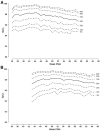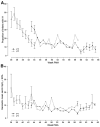Longitudinal assessment of hemoglobin oxygen saturation in preterm and term infants in the first six months of life
- PMID: 21481418
- PMCID: PMC3479632
- DOI: 10.1016/j.jpeds.2011.02.011
Longitudinal assessment of hemoglobin oxygen saturation in preterm and term infants in the first six months of life
Abstract
Objective: To report longitudinal home recordings of hemoglobin O(2) saturation by pulse oximetry (Spo(2)) during unperturbed sleep in preterm and term infants.
Study design: We recorded continuous pulse oximetry during the first 3 minutes of each hour of monitor use (nonevent epochs) for 103 preterm infants born at <1750 g and ≤ 34 weeks postmenstrual age (PMA), and 99 healthy term infants.
Results: Median baseline Spo(2) was approximately 98% for both the preterm and term groups. Episodes of intermittent hypoxemia occurred in 74% of preterm and 62% of term infants. Among infants with intermittent hypoxemia, the number of seconds/hour of monitoring <90% Spo(2) was initially significantly greater in the preterm than the term group and declined with age at a similar rate in both groups. The 75(th) to 95(th) percentiles for seconds/hour of Spo(2) <90% in preterm infants were highest at 36 weeks PMA and progressively decreased until 44 weeks PMA, after which time they did not differ from term infants.
Conclusions: Clinically inapparent intermittent hypoxemia occurs in epochs unperturbed by and temporally unrelated to apnea or bradycardia events, especially in preterm infants at 36 to 44 weeks PMA.
Copyright © 2011 Mosby, Inc. All rights reserved.
Conflict of interest statement
The authors declare no conflicts of interest.
Figures




References
-
- Neuman MR, Watson H, Mendenhall RS, et al. the Collaborative Home Infant Monitoring Evaluation (CHIME) Study Group. Cardiopulmonary monitoring at home: the CHIME monitor. Physiol Meas. 2001;22:267–86. - PubMed
-
- Ramanathan R, Corwin MJ, Hunt CE, et al. for the Collaborative Home Infant Monitoring Evaluation (CHIME) Study Group. Cardiorespiratory events recorded on home monitors: comparison of healthy infants with those at increased risk for SIDS. JAMA. 2001;285:2199–207. - PubMed
-
- Hunt CE, Corwin MJ, Lister G, et al. the Collaborative Home Infant Monitoring Evaluation (CHIME) Study Group. Longitudinal assessment of hemoglobin oxygen saturation in healthy infants during the first 6 months of age. J Pediatr. 1999;134:580–6. - PubMed
-
- Corwin MJ, Lister G, Silvestri JM the Collaborative Home Infant Monitoring Evaluation (CHIME) Study Group. Agreement among raters in assessment of physiologic waveforms recorded by a cardiorespiratory monitor for home use. Pediatr Res. 1998;44:682–90. - PubMed
-
- Singer JD, Willett JB. 2003 Applied longitudinal data analysis: modeling change and event occurrence. New York: Oxford University Press; 1994.
Publication types
MeSH terms
Substances
Grants and funding
LinkOut - more resources
Full Text Sources
Medical

